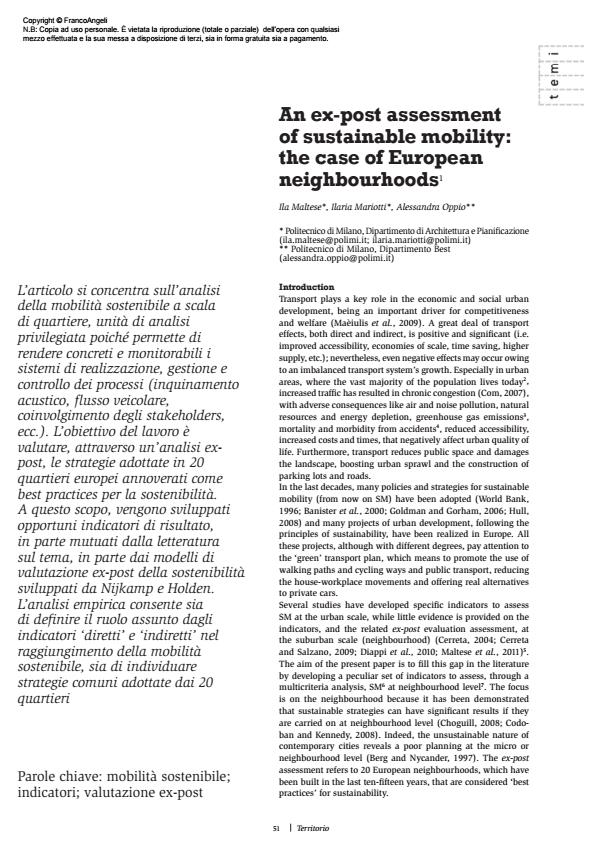An ex-post assessment of sustainable mobility: the case of European neighbourhoods
Journal title TERRITORIO
Author/s Ila Maltese, Ilaria Mariotti, Alessandra Oppio
Publishing Year 2011 Issue 2011/59
Language English Pages 8 P. 51-58 File size 400 KB
DOI 10.3280/TR2011-059008
DOI is like a bar code for intellectual property: to have more infomation
click here
Below, you can see the article first page
If you want to buy this article in PDF format, you can do it, following the instructions to buy download credits

FrancoAngeli is member of Publishers International Linking Association, Inc (PILA), a not-for-profit association which run the CrossRef service enabling links to and from online scholarly content.
This paper focuses on an analysis of sustainable mobility on a neighbourhood scale, a useful unit of analysis, because it makes the systems for the creation, management and control of processes (acoustic pollution, traffi c fl ow, stakeholder involvement, etc.) both concrete and monitorable. The objective of the work is to use an ex-post analysis to assess the strategies employed in twenty European neighbourhoods classified as pursuing best practices for sustainability. In order to perform this, appropriate results indicators were developed, taken in part from the literature on the subject and in part from ex-post sustainability assessment models developed by Nijkamp and Holden. Empirical analysis enabled us to define the role played by ‘direct’ and ‘indirect’ indicators in the achievement of sustainable mobility and also to identify common strategies employed by the twenty neighbourhoods concerned.
Keywords: Sustainable mobility; indicators; ex-post assessment
- International Conference on Transportation and Development 2025 Elnaz Safapour, Behzad Rouhanizadeh, Anupa Silwal, Michael D. Anderson, Mohammadsoroush Tafazzoli, pp.161 (DOI:10.1061/9780784486207.014)
- Public Participation in Transport in Times of Change Ila Maltese, Edoardo Marcucci, Valerio Gatta, Alessandro Sciullo, Tom Rye, pp.77 (ISBN:978-1-80455-038-0)
- The 2020 Italian Spring Lockdown: A Multidisciplinary Analysis over the Milan Urban Area Maurizio Migliaccio, Andrea Buono, Ila Maltese, Margherita Migliaccio, in World /2021 pp.391
DOI: 10.3390/world2030025 - Multicriteria versus Cost Benefit Analysis: a comparative perspective in the assessment of sustainable mobility Paolo Beria, Ila Maltese, Ilaria Mariotti, in European Transport Research Review /2012 pp.137
DOI: 10.1007/s12544-012-0074-9
Ila Maltese, Ilaria Mariotti, Alessandra Oppio, An ex-post assessment of sustainable mobility: the case of European neighbourhoods in "TERRITORIO" 59/2011, pp 51-58, DOI: 10.3280/TR2011-059008